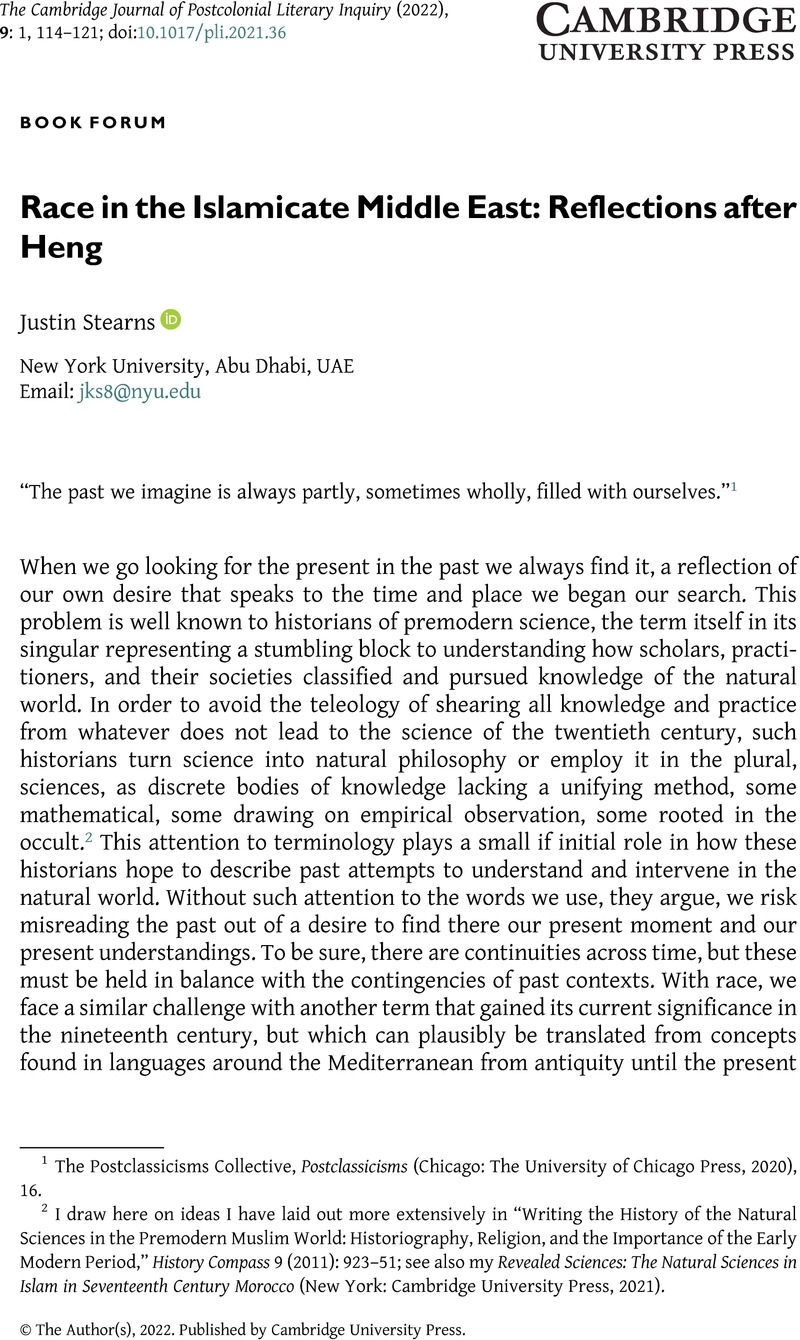No CrossRef data available.
Published online by Cambridge University Press: 21 February 2022

1 The Postclassicisms Collective, Postclassicisms (Chicago: The University of Chicago Press, 2020), 16.
2 I draw here on ideas I have laid out more extensively in “Writing the History of the Natural Sciences in the Premodern Muslim World: Historiography, Religion, and the Importance of the Early Modern Period,” History Compass 9 (2011): 923–51; see also my Revealed Sciences: The Natural Sciences in Islam in Seventeenth Century Morocco (New York: Cambridge University Press, 2021).
3 A handy survey of classical materials is found in Kennedy, Rebecca F., Roy, C. Sydnor, and Goldman, Max L. (eds. and trans.), Race and Ethnicity in the Classical World: An Anthology of Primary Sources in Translation (Indianapolis, IN: Hackett, 2013)Google Scholar.
4 Peter Webb, Imagining the Arabs: Arab Identity and the Rise of Islam (Edinburgh: Edinburgh University Press, 2016); on ethnogenesis, see the entry by Helmut Reimitz, “Ethnogenesis,” in Encyclopedia of the Ancient World (https://doi.org/10.1002/9781444338386.wbeah12081). A thoughtful review and critique of Webb’s book can be found in Robert G. Hoyland, “Reflections on the Identity of the Arabian Conquerors of the Seventh-Century Middle East,” al-‘Uṣūr al-Wuṣṭā 25 (2017): 113–40.
5 Kafadar, Cemal, “A Rome of One’s Own: Reflections on Cultural Geography and Identity in the Lands of Rum,” Muqarnas 24 (2007): 7–25 CrossRefGoogle Scholar; Kaldellis, Anthony, Romanland: Ethnicity and Empire in Byzantium (Cambridge, MA: Harvard University Press, 2019)Google Scholar.
6 For the early period of the Islamicate world, see here also the work of Savant, Sarah, The New Muslims of Post-Conquest Iran: Tradition, Memory and Conversion (Cambridge: Cambridge University Press, 2013)CrossRefGoogle Scholar, and Urban, Elizabeth, Conquered Populations in Early Islam: Non-Arabs, Slaves and the Sons of Slave Mothers (Edinburgh: Edinburgh University Press, 2020)CrossRefGoogle Scholar.
7 Hoyland, Robert, “Physiognomy in Islam,” Jerusalem Studies in Arabic and Islam 20 (2005): 361–402 Google Scholar.
8 Richardson, Kristina L., “Blue and Green Eyes in the Islamicate Middle Ages,” Annales Islamologiques 48 (2014): 13–29 CrossRefGoogle Scholar, and Richardson, Kristina L., Difference and Disability in the Medieval Islamic World (Edinburgh: Edinburgh University Press, 2012)CrossRefGoogle Scholar. For a comprehensive survey of Islamicate views of European Christians, see Daniel König, Arabic-Islamic Views of the Latin West: Tracing the Emergence of Medieval Europe (Oxford: Oxford University Press, 2016).
9 For a particularly vivid depiction of racialization occurring in a description of slaves, see the excerpt of the Nestorian Christian Ibn Buṭlān’s (d. 436/1075) On Buying Slaves included in Bernard Lewis, Islam (Oxford: Oxford University Press, 1987), 2:243–51.
10 See Al-Jāḥiẓ, “The Boasts of the Blacks Over the Whites” (“Fakhr al-Sūdān ‘alā-l-Bīḍān”), trans. Tarif Khalidi. Islamic Quarterly 25 (1981): 3–51. For it being unclear whether al-Jahiz himself possessed African ancestry, see Hefter, Thomas, The Reader in al-Jāḥiẓ (Edinburgh: Edinburgh University Press, 2014), 127–29CrossRefGoogle Scholar. On the epic of ‘Antar, see Rachel Schine, “Epic Worlds: The Racial Worlds of the Arabic Sīras,” forthcoming.
11 See Goldenberg, David, “The Development of the Idea of Race: Classical Paradigms and Medieval Elaborations,” International Journal of the Classical Tradition 5 (1999): 561–70CrossRefGoogle Scholar; Braude, Benjamin, “The Sons of Noah and the Construction of Ethnic and Geographical Identities in the Medieval and Early Modern Periods,” The William and Mary Quarterly 54.1 (1997): 103–42CrossRefGoogle Scholar.
12 Hall, Bruce, A History of Race in Muslim West Africa, 1600–1960 (Cambridge and New York: Cambridge University Press, 2011)CrossRefGoogle Scholar.
13 Glassman, Jonathan, War of Words, War of Stones: Racial Thought and Violence in Colonial Zanzibar (Bloomington: Indiana University Press, 2011)Google Scholar, and Jonathan Glassman, “Ethnicity and Race in African Thought,” A Companion to African History, eds. William H. Worger, Charles Ambler, and Nwando Achebe (Hoboken, NJ: Wiley, 2019), 199–223.
14 El Hamel, Chouki, Black Morocco: A History of Slavery, Race, and Islam (Cambridge: Cambridge University Press, 2013)Google Scholar; on Aḥmad Bābā, see al-Tinbuktī, Aḥmad Bābā, al-Su’ud, Mi’raj: Aḥmad Bābā’s Replies on Slavery, eds. and trans. Hunwick, John and Harrak, Fatima (Rabat: Institute of African Studies, 2000)Google Scholar, and Cleaveland, Timothy, “Ahmad Baba al-Timbukti and His Islamic Critique of Racial Slavery in the Maghrib,” The Journal of North African Studies 20.1 (2015): 42–64 CrossRefGoogle Scholar.
15 See Fynn-Paul, Jeffrey, “Introduction: Slaving Zones in Global History: The Evolution of a Concept,” in Slaving Zones: Cultural Identities, Ideologies, and Institutions in the Evolution of Global Slavery, eds Damian Pargas and Jeffrey Fynn-Paul (Leiden: Brill, 2018), 1–22 CrossRefGoogle Scholar.
16 Fields, Karen and Fields, Barbara, Racecraft: The Soul of Inequality in American Life (New York: Verso Books, 2014)Google Scholar.
17 I have benefitted here from the nuanced and thoughtful previously cited collaborative volume Postclassicisms.
18 For a representative example, see Fowden, Garth, Before and After Muhammed: The First Millennium Refocused (Princeton, NJ: Princeton University Press, 2015)Google Scholar.
19 For a useful overview of some of the challenges and opportunities posed by globalizing the Middle Ages, see Alan Strathern, “Global Early Modernity and the Problem of What Came Before,” Past and Present: The Global Middle Ages 238, suppl. 13 (2018): 317–44.
20 On this episode, see Garciá-Arenal, Mercedes, “Les bildiyyin de Fes: un groupe de neo-musulmans d’origine juive,” Studia Islamica 66 (1987): 113–43CrossRefGoogle Scholar.
21 Sarah Pearce’s engagement with Heng is much more extensive than my own. See Sarah Pearce, “The Inquisitor and the Moseret: The Invention of Race in the European Middle Ages and the New English Colonialism in Jewish Historiography,” Medieval Encounters 26 (2020): 145–90.
22 Kim, Dorothy, “Introduction oo Literature Compass Special Cluster: Critical Race and the Middle Ages,” Literature Compass 16 (2019): 1–16 CrossRefGoogle Scholar.
23 See Nirenberg, David, “Was There Race before Modernity? The Example of ‘Jewish’ Blood in Late Medieval Spain,” in The Origins of Racism in the West, eds. Eliav-Feldon, Miriam, et al. (Cambridge: Cambridge University Press, 2009), 232–64Google Scholar. This is the very chapter that so frustrated Kim in her introduction to her edited special issue Critical Race and the Middle Ages.
24 Bauer, Thomas, Warum es kein islamisches Mittelalter gab. Das Erbe der Antike und der Orient (Munich: C. H. Beck, 2018)CrossRefGoogle Scholar.